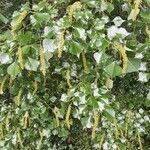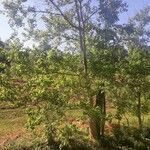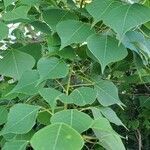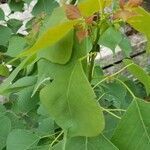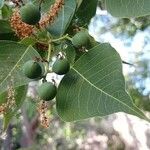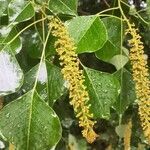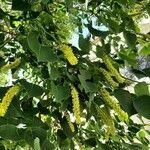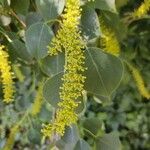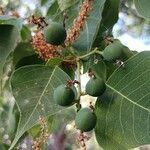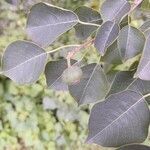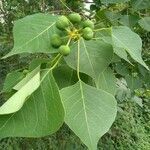Trees, to 13 m (fertile from 1 m). Leaves: stipules persistent, elliptic, 0.7–1 × 0.5–0.7 mm; petiole 2–7 cm, glands 2, discoid, adaxial; blade ovate to broadly elliptic or rhomboid, 3.5–10 × 3–9.5 cm, base broadly cuneate to nearly truncate, apex acuminate; laminar glands 0–10, elliptic, 0.3 × 0.2 mm, usually on distal 1/2 of leaf. Inflorescences to 20 cm; staminate cymules numerous, 10–20 flowered, bracts ovate, 1.5 mm, subtended by 2[–4] ellipsoid glands; pistillate flowers 0–6 per inflorescence, 1 per bract (often in bisexual cymules with 0–5 staminate flowers), bracts of basal flowers usually not subtended by ellipsoid glands. Pedicels: staminate 1.5–3 mm; pistillate 1–2 mm, to 12 mm in fruit. Staminate flowers yellow; sepals 0.5–1 mm, shallowly 3-lobed, margins erose; filaments to 0.2–0.3 mm; anthers 0.5 mm. Pistillate flowers yellowish green; sepals 2–3 × 1 mm, apex acuminate; styles 4–8 mm, coiled distally. Capsules 1–1.3 cm diam., subglobose, trigonous; columella 1 cm. Seeds 6–9 × 4–7 mm, usually remaining attached to columella; outer seed coat white, waxy; inner coat woody, brown, smooth. 2n = 88.
A tree which loses its leaves. It grows 6-9 m high and spreads 4.5-6 m wide. It has a rounded crown. The leaves are 5-10 cm long. They are rounded or almost diamond shaped and dull green. The leaves turn orange or red in autumn. The flowers are yellow-green. The fruit are about the size of peas. The fruit splits open to reveal 3 seeds. These are covered with a layer of pure wax. The seeds are 6 mm across.
